Innovation and Sustainable Business Development Report - Analysis
VerifiedAdded on 2020/02/24
|10
|6102
|98
Report
AI Summary
This report delves into the realms of innovation and sustainable business development, exploring the intricacies of business models as defined by Zott, Amit, and Massa. It dissects key concepts such as e-business archetypes, business models as activity systems, and cost/revenue architectures, highlighting their significance in achieving competitive advantage. The report emphasizes the dynamic nature of business environments, illustrated by the case of Coca-Cola Amatil's adoption of cloud computing to enhance operational efficiency and customer experience. It further examines the importance of adapting business models to changing customer needs and technological advancements, underscoring the role of innovation in navigating static and dynamic business challenges. The report also explores the implications of business context, emphasizing the need for organizations to stay ahead of market competition by creating competitive edges through technological adoption and customer-centric approaches. The framework covers value proposition, key activities, cost structure, key resources, client relationships, revenue flows, distribution channels, partner network, and client segments. The study concludes by reiterating the importance of the business model as a framework for exploring business opportunities and achieving sustainable growth.
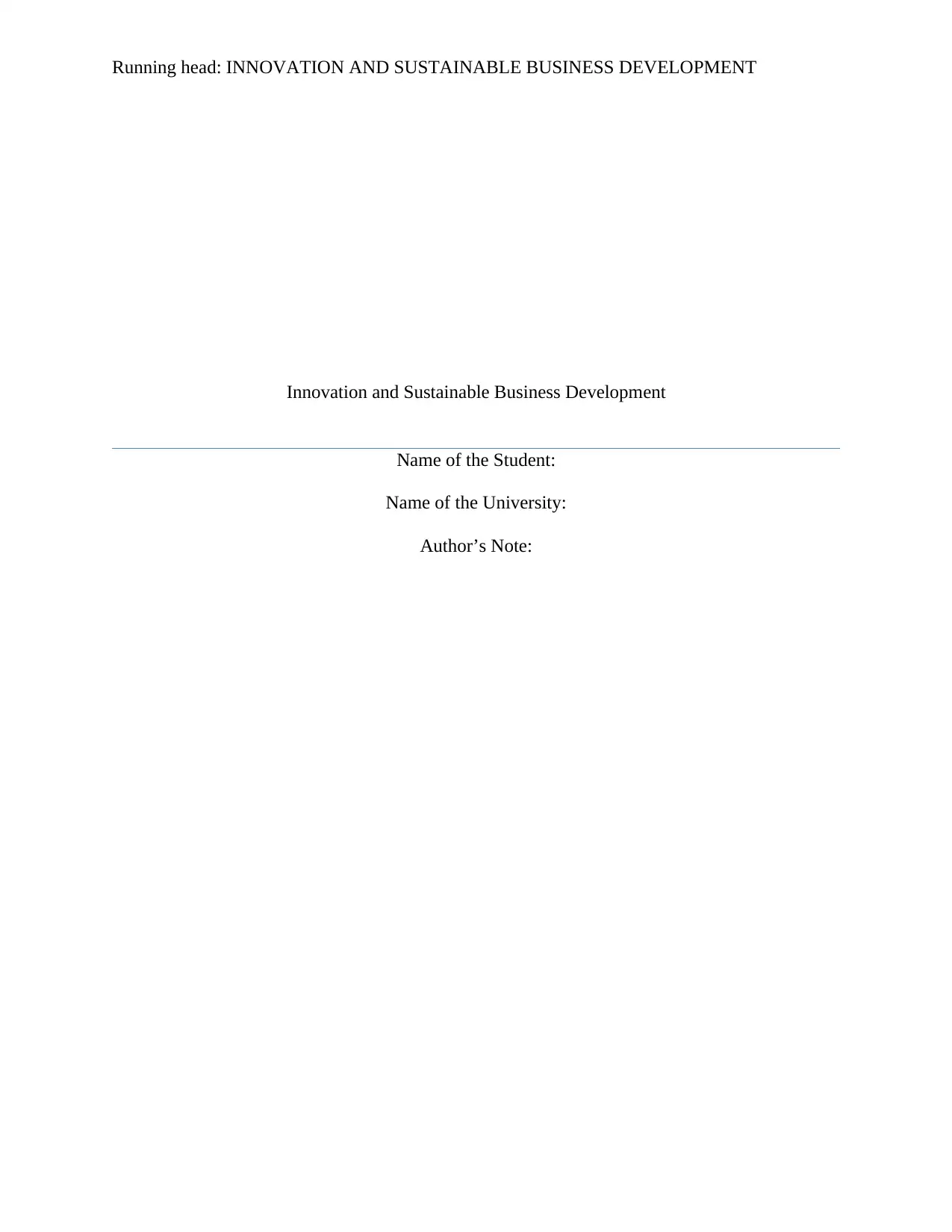
Running head: INNOVATION AND SUSTAINABLE BUSINESS DEVELOPMENT
Innovation and Sustainable Business Development
Name of the Student:
Name of the University:
Author’s Note:
Innovation and Sustainable Business Development
Name of the Student:
Name of the University:
Author’s Note:
Paraphrase This Document
Need a fresh take? Get an instant paraphrase of this document with our AI Paraphraser
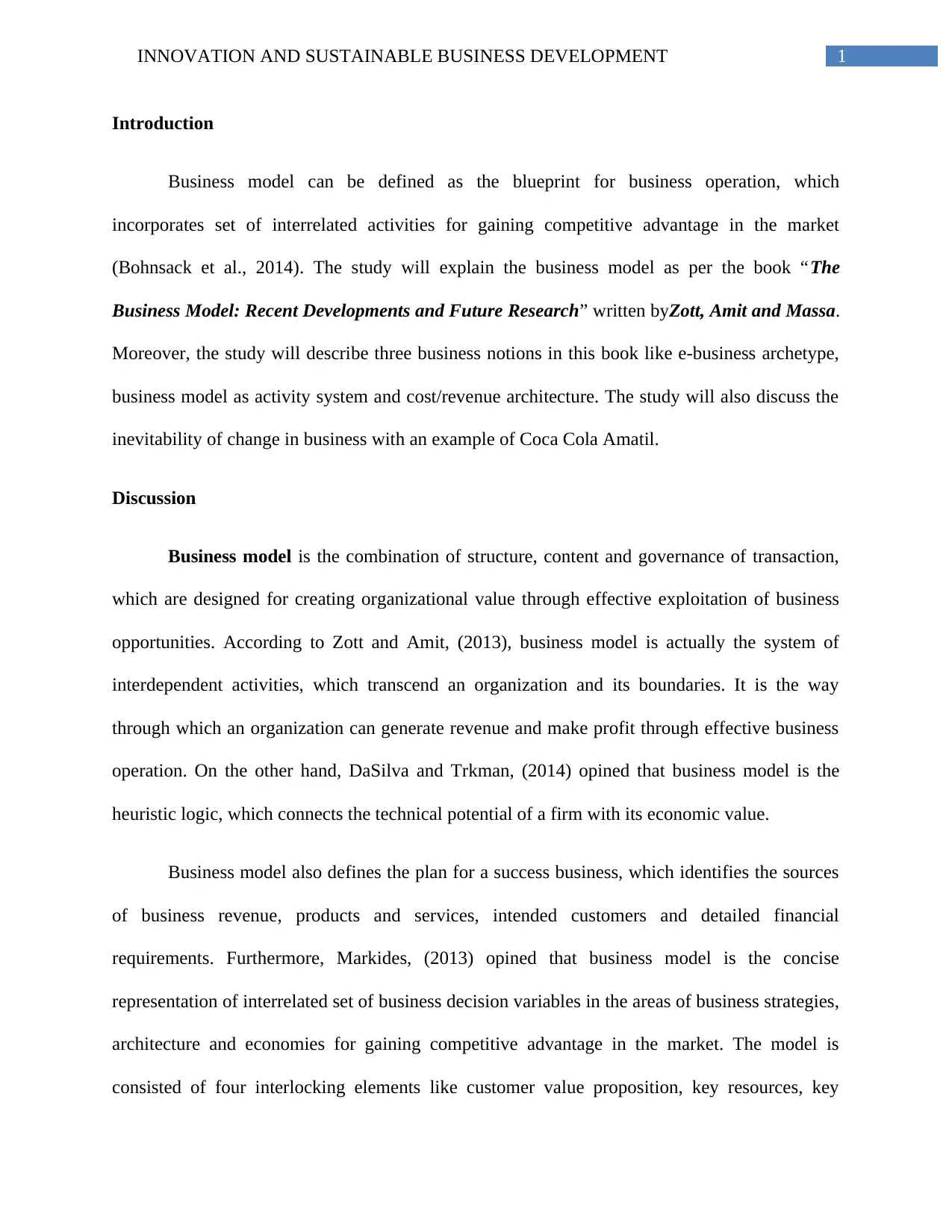
1INNOVATION AND SUSTAINABLE BUSINESS DEVELOPMENT
Introduction
Business model can be defined as the blueprint for business operation, which
incorporates set of interrelated activities for gaining competitive advantage in the market
(Bohnsack et al., 2014). The study will explain the business model as per the book “The
Business Model: Recent Developments and Future Research” written byZott, Amit and Massa.
Moreover, the study will describe three business notions in this book like e-business archetype,
business model as activity system and cost/revenue architecture. The study will also discuss the
inevitability of change in business with an example of Coca Cola Amatil.
Discussion
Business model is the combination of structure, content and governance of transaction,
which are designed for creating organizational value through effective exploitation of business
opportunities. According to Zott and Amit, (2013), business model is actually the system of
interdependent activities, which transcend an organization and its boundaries. It is the way
through which an organization can generate revenue and make profit through effective business
operation. On the other hand, DaSilva and Trkman, (2014) opined that business model is the
heuristic logic, which connects the technical potential of a firm with its economic value.
Business model also defines the plan for a success business, which identifies the sources
of business revenue, products and services, intended customers and detailed financial
requirements. Furthermore, Markides, (2013) opined that business model is the concise
representation of interrelated set of business decision variables in the areas of business strategies,
architecture and economies for gaining competitive advantage in the market. The model is
consisted of four interlocking elements like customer value proposition, key resources, key
Introduction
Business model can be defined as the blueprint for business operation, which
incorporates set of interrelated activities for gaining competitive advantage in the market
(Bohnsack et al., 2014). The study will explain the business model as per the book “The
Business Model: Recent Developments and Future Research” written byZott, Amit and Massa.
Moreover, the study will describe three business notions in this book like e-business archetype,
business model as activity system and cost/revenue architecture. The study will also discuss the
inevitability of change in business with an example of Coca Cola Amatil.
Discussion
Business model is the combination of structure, content and governance of transaction,
which are designed for creating organizational value through effective exploitation of business
opportunities. According to Zott and Amit, (2013), business model is actually the system of
interdependent activities, which transcend an organization and its boundaries. It is the way
through which an organization can generate revenue and make profit through effective business
operation. On the other hand, DaSilva and Trkman, (2014) opined that business model is the
heuristic logic, which connects the technical potential of a firm with its economic value.
Business model also defines the plan for a success business, which identifies the sources
of business revenue, products and services, intended customers and detailed financial
requirements. Furthermore, Markides, (2013) opined that business model is the concise
representation of interrelated set of business decision variables in the areas of business strategies,
architecture and economies for gaining competitive advantage in the market. The model is
consisted of four interlocking elements like customer value proposition, key resources, key
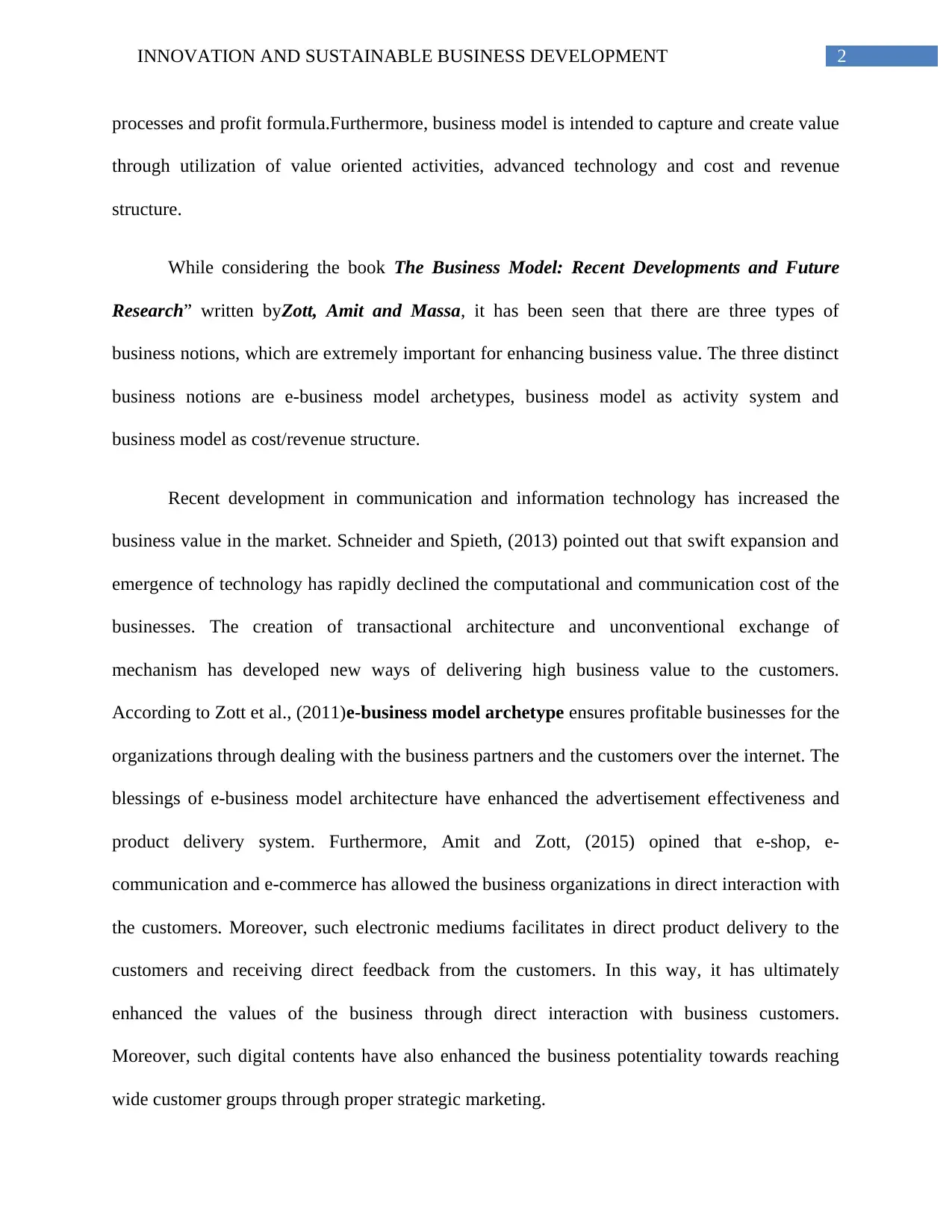
2INNOVATION AND SUSTAINABLE BUSINESS DEVELOPMENT
processes and profit formula.Furthermore, business model is intended to capture and create value
through utilization of value oriented activities, advanced technology and cost and revenue
structure.
While considering the book The Business Model: Recent Developments and Future
Research” written byZott, Amit and Massa, it has been seen that there are three types of
business notions, which are extremely important for enhancing business value. The three distinct
business notions are e-business model archetypes, business model as activity system and
business model as cost/revenue structure.
Recent development in communication and information technology has increased the
business value in the market. Schneider and Spieth, (2013) pointed out that swift expansion and
emergence of technology has rapidly declined the computational and communication cost of the
businesses. The creation of transactional architecture and unconventional exchange of
mechanism has developed new ways of delivering high business value to the customers.
According to Zott et al., (2011)e-business model archetype ensures profitable businesses for the
organizations through dealing with the business partners and the customers over the internet. The
blessings of e-business model architecture have enhanced the advertisement effectiveness and
product delivery system. Furthermore, Amit and Zott, (2015) opined that e-shop, e-
communication and e-commerce has allowed the business organizations in direct interaction with
the customers. Moreover, such electronic mediums facilitates in direct product delivery to the
customers and receiving direct feedback from the customers. In this way, it has ultimately
enhanced the values of the business through direct interaction with business customers.
Moreover, such digital contents have also enhanced the business potentiality towards reaching
wide customer groups through proper strategic marketing.
processes and profit formula.Furthermore, business model is intended to capture and create value
through utilization of value oriented activities, advanced technology and cost and revenue
structure.
While considering the book The Business Model: Recent Developments and Future
Research” written byZott, Amit and Massa, it has been seen that there are three types of
business notions, which are extremely important for enhancing business value. The three distinct
business notions are e-business model archetypes, business model as activity system and
business model as cost/revenue structure.
Recent development in communication and information technology has increased the
business value in the market. Schneider and Spieth, (2013) pointed out that swift expansion and
emergence of technology has rapidly declined the computational and communication cost of the
businesses. The creation of transactional architecture and unconventional exchange of
mechanism has developed new ways of delivering high business value to the customers.
According to Zott et al., (2011)e-business model archetype ensures profitable businesses for the
organizations through dealing with the business partners and the customers over the internet. The
blessings of e-business model architecture have enhanced the advertisement effectiveness and
product delivery system. Furthermore, Amit and Zott, (2015) opined that e-shop, e-
communication and e-commerce has allowed the business organizations in direct interaction with
the customers. Moreover, such electronic mediums facilitates in direct product delivery to the
customers and receiving direct feedback from the customers. In this way, it has ultimately
enhanced the values of the business through direct interaction with business customers.
Moreover, such digital contents have also enhanced the business potentiality towards reaching
wide customer groups through proper strategic marketing.
⊘ This is a preview!⊘
Do you want full access?
Subscribe today to unlock all pages.

Trusted by 1+ million students worldwide
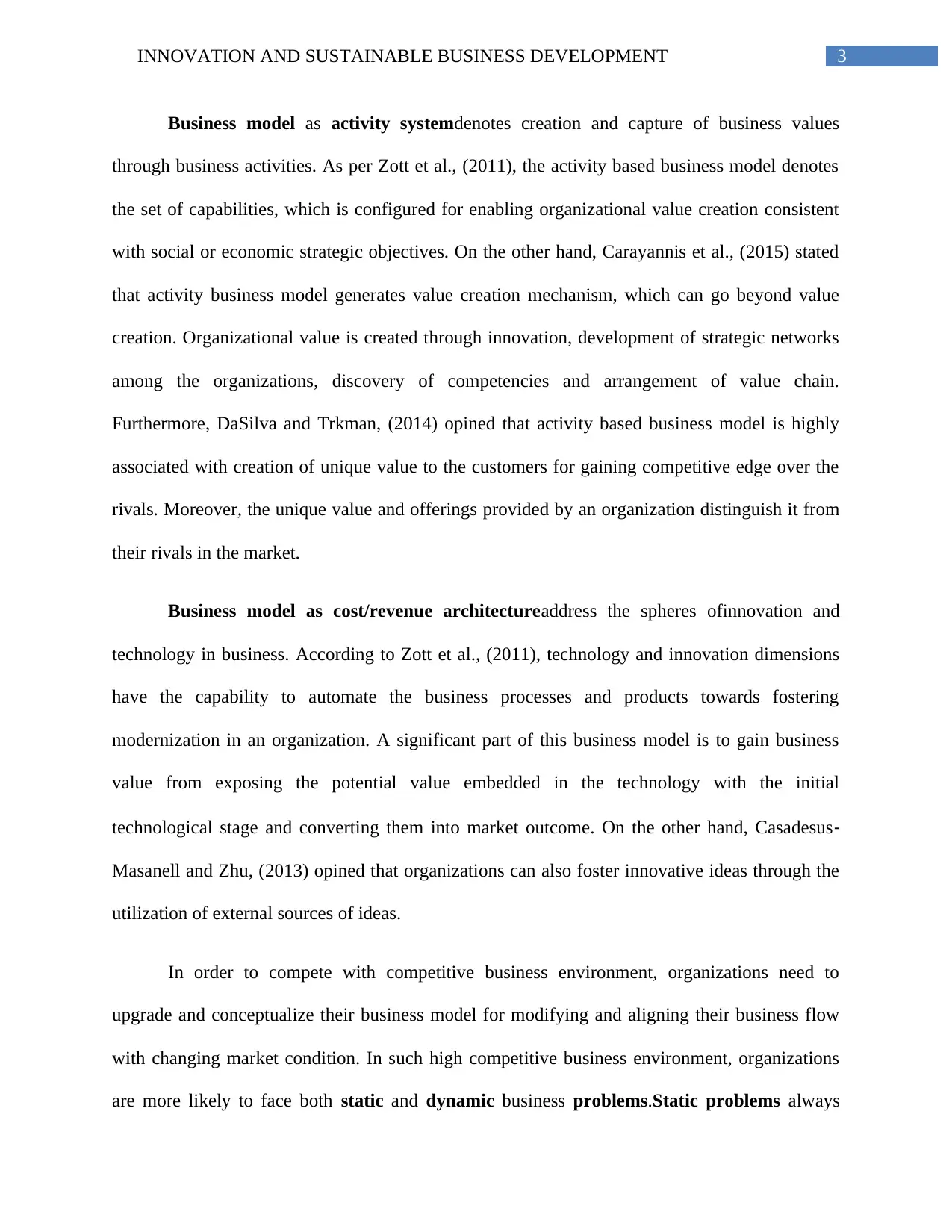
3INNOVATION AND SUSTAINABLE BUSINESS DEVELOPMENT
Business model as activity systemdenotes creation and capture of business values
through business activities. As per Zott et al., (2011), the activity based business model denotes
the set of capabilities, which is configured for enabling organizational value creation consistent
with social or economic strategic objectives. On the other hand, Carayannis et al., (2015) stated
that activity business model generates value creation mechanism, which can go beyond value
creation. Organizational value is created through innovation, development of strategic networks
among the organizations, discovery of competencies and arrangement of value chain.
Furthermore, DaSilva and Trkman, (2014) opined that activity based business model is highly
associated with creation of unique value to the customers for gaining competitive edge over the
rivals. Moreover, the unique value and offerings provided by an organization distinguish it from
their rivals in the market.
Business model as cost/revenue architectureaddress the spheres ofinnovation and
technology in business. According to Zott et al., (2011), technology and innovation dimensions
have the capability to automate the business processes and products towards fostering
modernization in an organization. A significant part of this business model is to gain business
value from exposing the potential value embedded in the technology with the initial
technological stage and converting them into market outcome. On the other hand, Casadesus‐
Masanell and Zhu, (2013) opined that organizations can also foster innovative ideas through the
utilization of external sources of ideas.
In order to compete with competitive business environment, organizations need to
upgrade and conceptualize their business model for modifying and aligning their business flow
with changing market condition. In such high competitive business environment, organizations
are more likely to face both static and dynamic business problems.Static problems always
Business model as activity systemdenotes creation and capture of business values
through business activities. As per Zott et al., (2011), the activity based business model denotes
the set of capabilities, which is configured for enabling organizational value creation consistent
with social or economic strategic objectives. On the other hand, Carayannis et al., (2015) stated
that activity business model generates value creation mechanism, which can go beyond value
creation. Organizational value is created through innovation, development of strategic networks
among the organizations, discovery of competencies and arrangement of value chain.
Furthermore, DaSilva and Trkman, (2014) opined that activity based business model is highly
associated with creation of unique value to the customers for gaining competitive edge over the
rivals. Moreover, the unique value and offerings provided by an organization distinguish it from
their rivals in the market.
Business model as cost/revenue architectureaddress the spheres ofinnovation and
technology in business. According to Zott et al., (2011), technology and innovation dimensions
have the capability to automate the business processes and products towards fostering
modernization in an organization. A significant part of this business model is to gain business
value from exposing the potential value embedded in the technology with the initial
technological stage and converting them into market outcome. On the other hand, Casadesus‐
Masanell and Zhu, (2013) opined that organizations can also foster innovative ideas through the
utilization of external sources of ideas.
In order to compete with competitive business environment, organizations need to
upgrade and conceptualize their business model for modifying and aligning their business flow
with changing market condition. In such high competitive business environment, organizations
are more likely to face both static and dynamic business problems.Static problems always
Paraphrase This Document
Need a fresh take? Get an instant paraphrase of this document with our AI Paraphraser
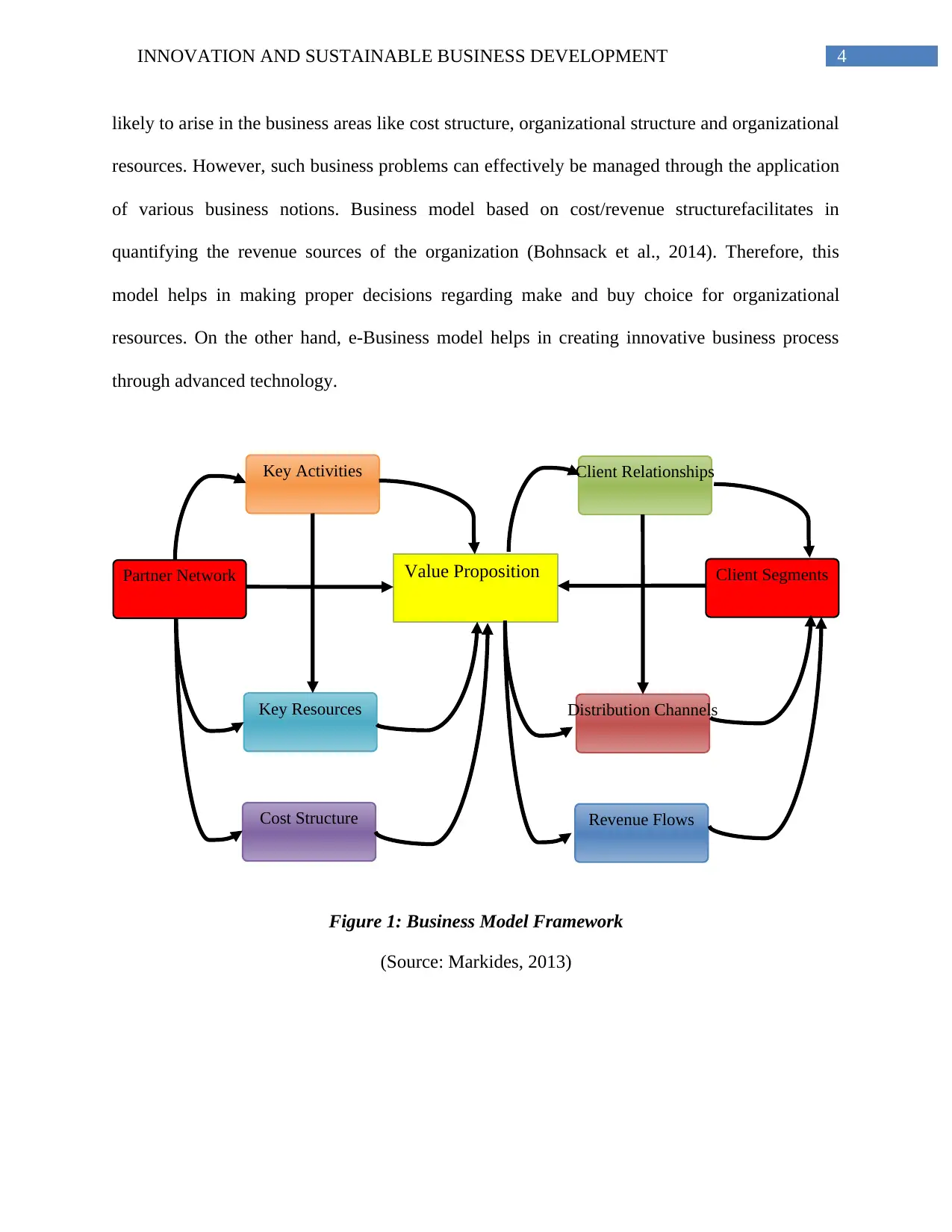
4INNOVATION AND SUSTAINABLE BUSINESS DEVELOPMENT
Value Proposition
Key Activities
Cost Structure
Key Resources
Client Relationships
Revenue Flows
Distribution Channels
Partner Network Client Segments
likely to arise in the business areas like cost structure, organizational structure and organizational
resources. However, such business problems can effectively be managed through the application
of various business notions. Business model based on cost/revenue structurefacilitates in
quantifying the revenue sources of the organization (Bohnsack et al., 2014). Therefore, this
model helps in making proper decisions regarding make and buy choice for organizational
resources. On the other hand, e-Business model helps in creating innovative business process
through advanced technology.
Figure 1: Business Model Framework
(Source: Markides, 2013)
Value Proposition
Key Activities
Cost Structure
Key Resources
Client Relationships
Revenue Flows
Distribution Channels
Partner Network Client Segments
likely to arise in the business areas like cost structure, organizational structure and organizational
resources. However, such business problems can effectively be managed through the application
of various business notions. Business model based on cost/revenue structurefacilitates in
quantifying the revenue sources of the organization (Bohnsack et al., 2014). Therefore, this
model helps in making proper decisions regarding make and buy choice for organizational
resources. On the other hand, e-Business model helps in creating innovative business process
through advanced technology.
Figure 1: Business Model Framework
(Source: Markides, 2013)
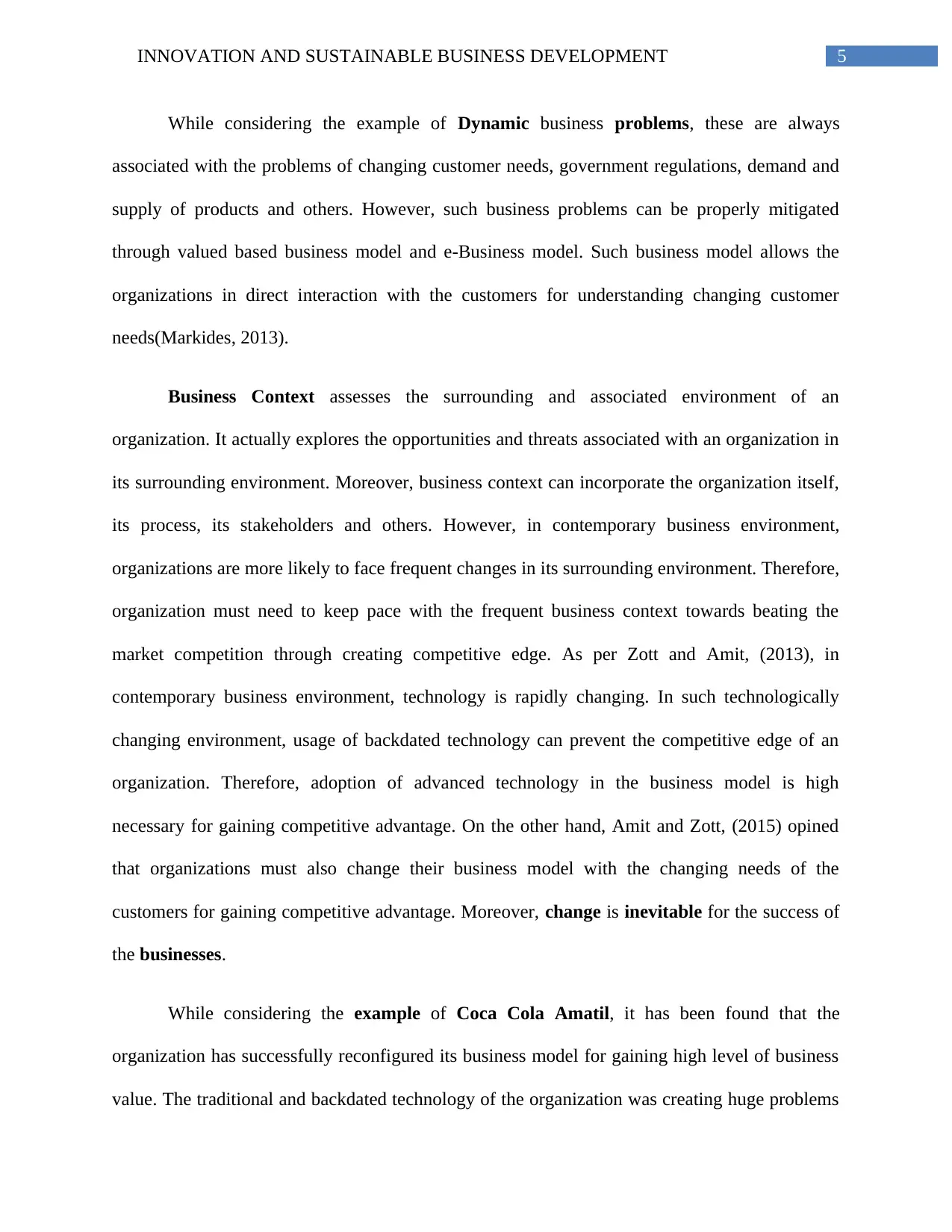
5INNOVATION AND SUSTAINABLE BUSINESS DEVELOPMENT
While considering the example of Dynamic business problems, these are always
associated with the problems of changing customer needs, government regulations, demand and
supply of products and others. However, such business problems can be properly mitigated
through valued based business model and e-Business model. Such business model allows the
organizations in direct interaction with the customers for understanding changing customer
needs(Markides, 2013).
Business Context assesses the surrounding and associated environment of an
organization. It actually explores the opportunities and threats associated with an organization in
its surrounding environment. Moreover, business context can incorporate the organization itself,
its process, its stakeholders and others. However, in contemporary business environment,
organizations are more likely to face frequent changes in its surrounding environment. Therefore,
organization must need to keep pace with the frequent business context towards beating the
market competition through creating competitive edge. As per Zott and Amit, (2013), in
contemporary business environment, technology is rapidly changing. In such technologically
changing environment, usage of backdated technology can prevent the competitive edge of an
organization. Therefore, adoption of advanced technology in the business model is high
necessary for gaining competitive advantage. On the other hand, Amit and Zott, (2015) opined
that organizations must also change their business model with the changing needs of the
customers for gaining competitive advantage. Moreover, change is inevitable for the success of
the businesses.
While considering the example of Coca Cola Amatil, it has been found that the
organization has successfully reconfigured its business model for gaining high level of business
value. The traditional and backdated technology of the organization was creating huge problems
While considering the example of Dynamic business problems, these are always
associated with the problems of changing customer needs, government regulations, demand and
supply of products and others. However, such business problems can be properly mitigated
through valued based business model and e-Business model. Such business model allows the
organizations in direct interaction with the customers for understanding changing customer
needs(Markides, 2013).
Business Context assesses the surrounding and associated environment of an
organization. It actually explores the opportunities and threats associated with an organization in
its surrounding environment. Moreover, business context can incorporate the organization itself,
its process, its stakeholders and others. However, in contemporary business environment,
organizations are more likely to face frequent changes in its surrounding environment. Therefore,
organization must need to keep pace with the frequent business context towards beating the
market competition through creating competitive edge. As per Zott and Amit, (2013), in
contemporary business environment, technology is rapidly changing. In such technologically
changing environment, usage of backdated technology can prevent the competitive edge of an
organization. Therefore, adoption of advanced technology in the business model is high
necessary for gaining competitive advantage. On the other hand, Amit and Zott, (2015) opined
that organizations must also change their business model with the changing needs of the
customers for gaining competitive advantage. Moreover, change is inevitable for the success of
the businesses.
While considering the example of Coca Cola Amatil, it has been found that the
organization has successfully reconfigured its business model for gaining high level of business
value. The traditional and backdated technology of the organization was creating huge problems
⊘ This is a preview!⊘
Do you want full access?
Subscribe today to unlock all pages.

Trusted by 1+ million students worldwide
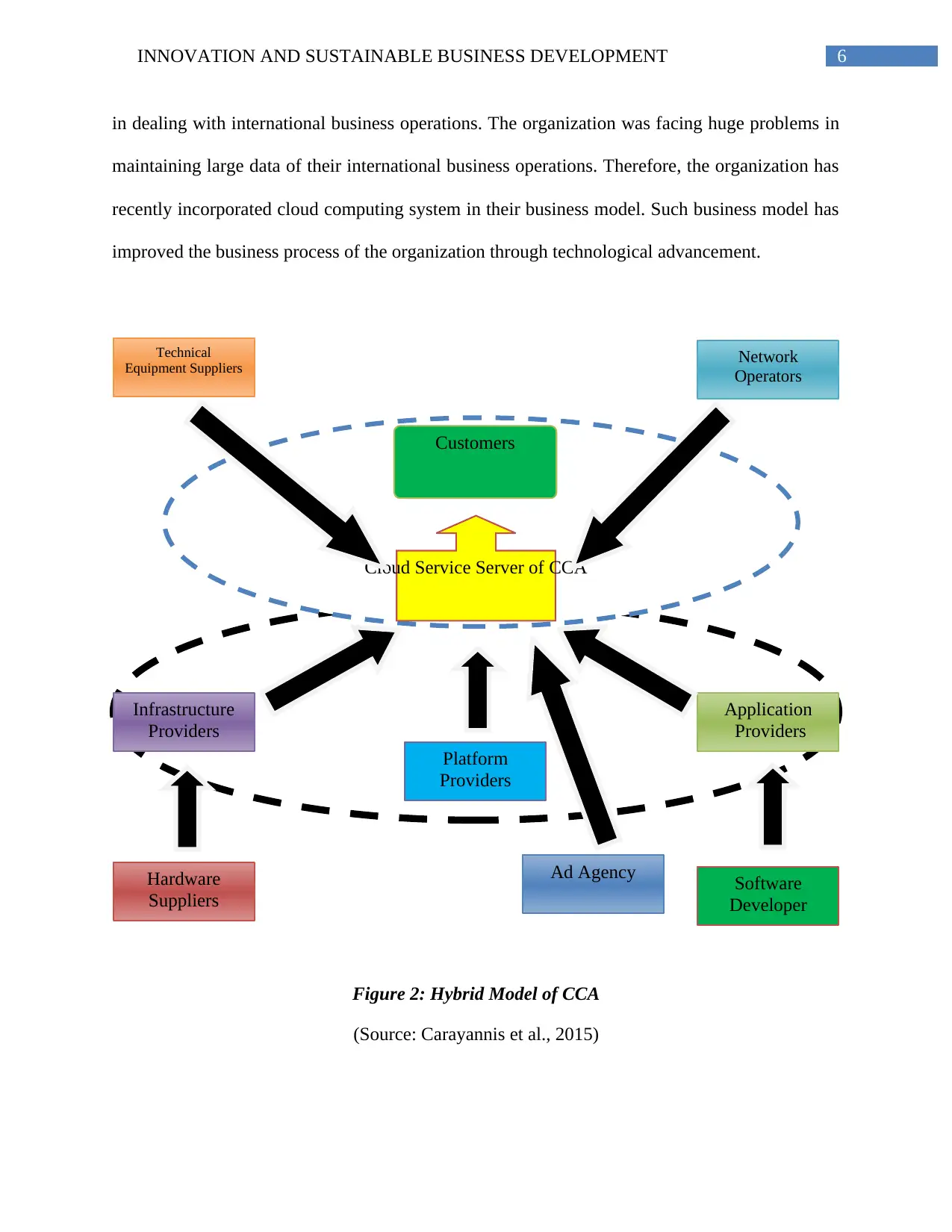
6INNOVATION AND SUSTAINABLE BUSINESS DEVELOPMENT
Cloud Service Server of CCA
Customers
Technical
Equipment Suppliers Network
Operators
Application
Providers
Infrastructure
Providers
Software
Developer
Hardware
Suppliers
Platform
Providers
Ad Agency
in dealing with international business operations. The organization was facing huge problems in
maintaining large data of their international business operations. Therefore, the organization has
recently incorporated cloud computing system in their business model. Such business model has
improved the business process of the organization through technological advancement.
Figure 2: Hybrid Model of CCA
(Source: Carayannis et al., 2015)
Cloud Service Server of CCA
Customers
Technical
Equipment Suppliers Network
Operators
Application
Providers
Infrastructure
Providers
Software
Developer
Hardware
Suppliers
Platform
Providers
Ad Agency
in dealing with international business operations. The organization was facing huge problems in
maintaining large data of their international business operations. Therefore, the organization has
recently incorporated cloud computing system in their business model. Such business model has
improved the business process of the organization through technological advancement.
Figure 2: Hybrid Model of CCA
(Source: Carayannis et al., 2015)
Paraphrase This Document
Need a fresh take? Get an instant paraphrase of this document with our AI Paraphraser
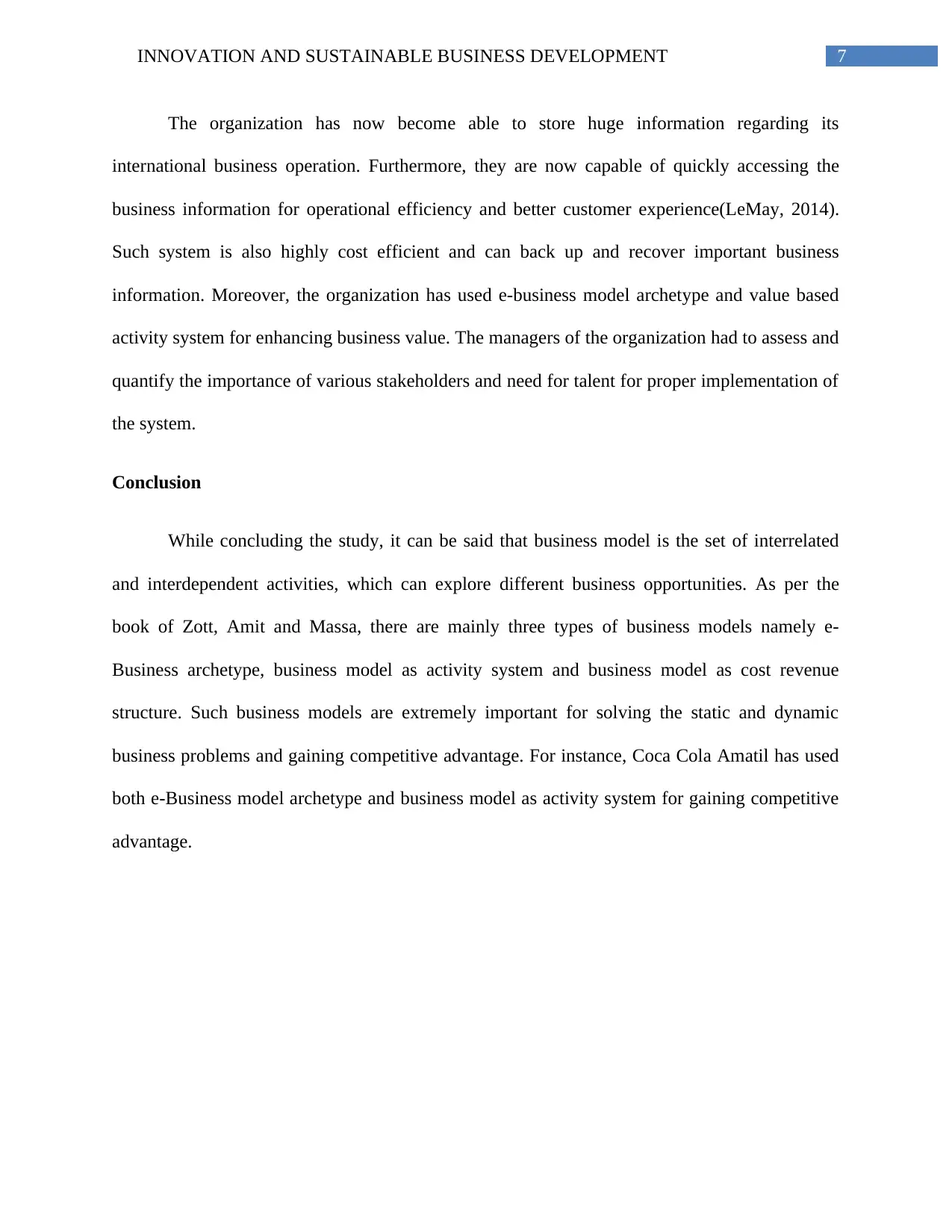
7INNOVATION AND SUSTAINABLE BUSINESS DEVELOPMENT
The organization has now become able to store huge information regarding its
international business operation. Furthermore, they are now capable of quickly accessing the
business information for operational efficiency and better customer experience(LeMay, 2014).
Such system is also highly cost efficient and can back up and recover important business
information. Moreover, the organization has used e-business model archetype and value based
activity system for enhancing business value. The managers of the organization had to assess and
quantify the importance of various stakeholders and need for talent for proper implementation of
the system.
Conclusion
While concluding the study, it can be said that business model is the set of interrelated
and interdependent activities, which can explore different business opportunities. As per the
book of Zott, Amit and Massa, there are mainly three types of business models namely e-
Business archetype, business model as activity system and business model as cost revenue
structure. Such business models are extremely important for solving the static and dynamic
business problems and gaining competitive advantage. For instance, Coca Cola Amatil has used
both e-Business model archetype and business model as activity system for gaining competitive
advantage.
The organization has now become able to store huge information regarding its
international business operation. Furthermore, they are now capable of quickly accessing the
business information for operational efficiency and better customer experience(LeMay, 2014).
Such system is also highly cost efficient and can back up and recover important business
information. Moreover, the organization has used e-business model archetype and value based
activity system for enhancing business value. The managers of the organization had to assess and
quantify the importance of various stakeholders and need for talent for proper implementation of
the system.
Conclusion
While concluding the study, it can be said that business model is the set of interrelated
and interdependent activities, which can explore different business opportunities. As per the
book of Zott, Amit and Massa, there are mainly three types of business models namely e-
Business archetype, business model as activity system and business model as cost revenue
structure. Such business models are extremely important for solving the static and dynamic
business problems and gaining competitive advantage. For instance, Coca Cola Amatil has used
both e-Business model archetype and business model as activity system for gaining competitive
advantage.
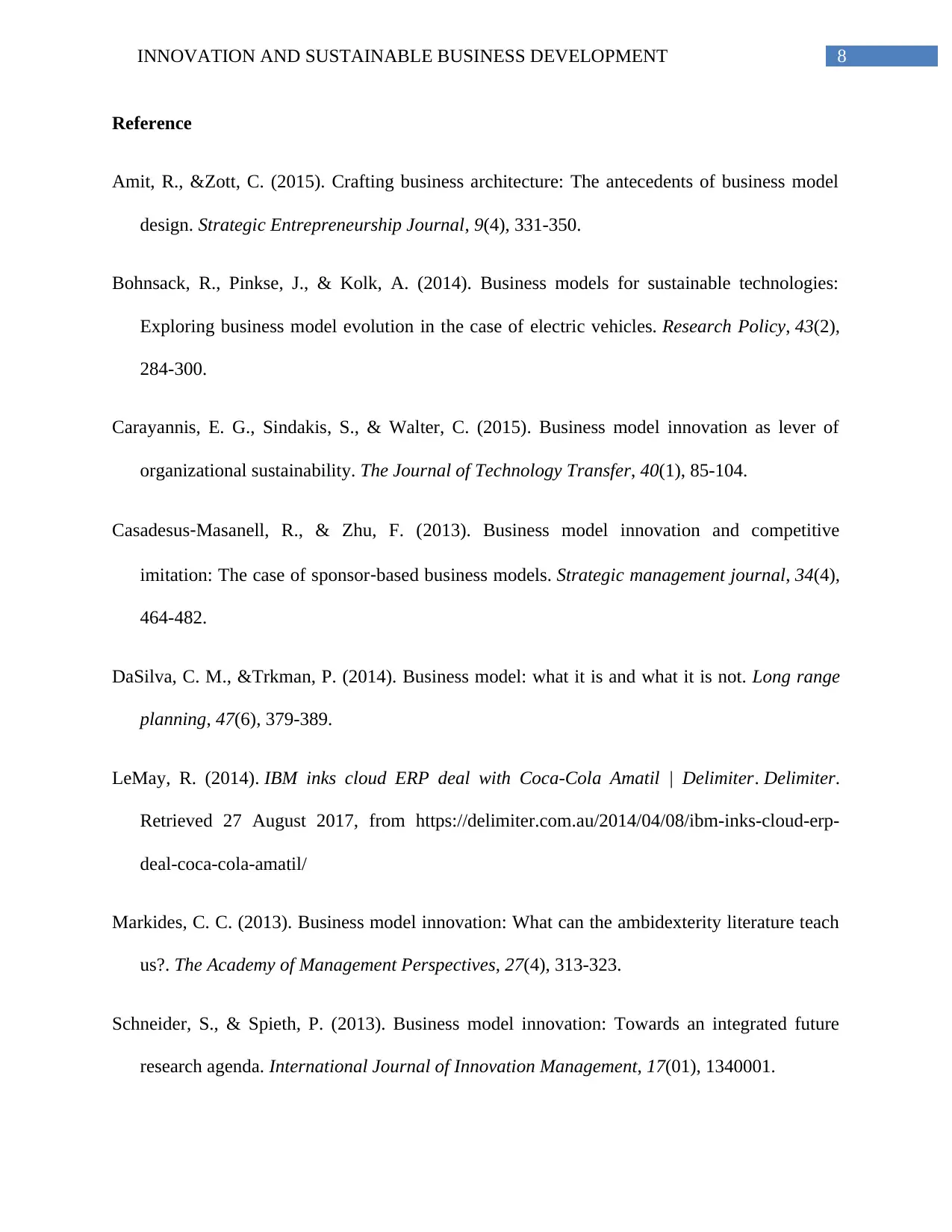
8INNOVATION AND SUSTAINABLE BUSINESS DEVELOPMENT
Reference
Amit, R., &Zott, C. (2015). Crafting business architecture: The antecedents of business model
design. Strategic Entrepreneurship Journal, 9(4), 331-350.
Bohnsack, R., Pinkse, J., & Kolk, A. (2014). Business models for sustainable technologies:
Exploring business model evolution in the case of electric vehicles. Research Policy, 43(2),
284-300.
Carayannis, E. G., Sindakis, S., & Walter, C. (2015). Business model innovation as lever of
organizational sustainability. The Journal of Technology Transfer, 40(1), 85-104.
Casadesus‐Masanell, R., & Zhu, F. (2013). Business model innovation and competitive
imitation: The case of sponsor‐based business models. Strategic management journal, 34(4),
464-482.
DaSilva, C. M., &Trkman, P. (2014). Business model: what it is and what it is not. Long range
planning, 47(6), 379-389.
LeMay, R. (2014). IBM inks cloud ERP deal with Coca-Cola Amatil | Delimiter. Delimiter.
Retrieved 27 August 2017, from https://delimiter.com.au/2014/04/08/ibm-inks-cloud-erp-
deal-coca-cola-amatil/
Markides, C. C. (2013). Business model innovation: What can the ambidexterity literature teach
us?. The Academy of Management Perspectives, 27(4), 313-323.
Schneider, S., & Spieth, P. (2013). Business model innovation: Towards an integrated future
research agenda. International Journal of Innovation Management, 17(01), 1340001.
Reference
Amit, R., &Zott, C. (2015). Crafting business architecture: The antecedents of business model
design. Strategic Entrepreneurship Journal, 9(4), 331-350.
Bohnsack, R., Pinkse, J., & Kolk, A. (2014). Business models for sustainable technologies:
Exploring business model evolution in the case of electric vehicles. Research Policy, 43(2),
284-300.
Carayannis, E. G., Sindakis, S., & Walter, C. (2015). Business model innovation as lever of
organizational sustainability. The Journal of Technology Transfer, 40(1), 85-104.
Casadesus‐Masanell, R., & Zhu, F. (2013). Business model innovation and competitive
imitation: The case of sponsor‐based business models. Strategic management journal, 34(4),
464-482.
DaSilva, C. M., &Trkman, P. (2014). Business model: what it is and what it is not. Long range
planning, 47(6), 379-389.
LeMay, R. (2014). IBM inks cloud ERP deal with Coca-Cola Amatil | Delimiter. Delimiter.
Retrieved 27 August 2017, from https://delimiter.com.au/2014/04/08/ibm-inks-cloud-erp-
deal-coca-cola-amatil/
Markides, C. C. (2013). Business model innovation: What can the ambidexterity literature teach
us?. The Academy of Management Perspectives, 27(4), 313-323.
Schneider, S., & Spieth, P. (2013). Business model innovation: Towards an integrated future
research agenda. International Journal of Innovation Management, 17(01), 1340001.
⊘ This is a preview!⊘
Do you want full access?
Subscribe today to unlock all pages.

Trusted by 1+ million students worldwide
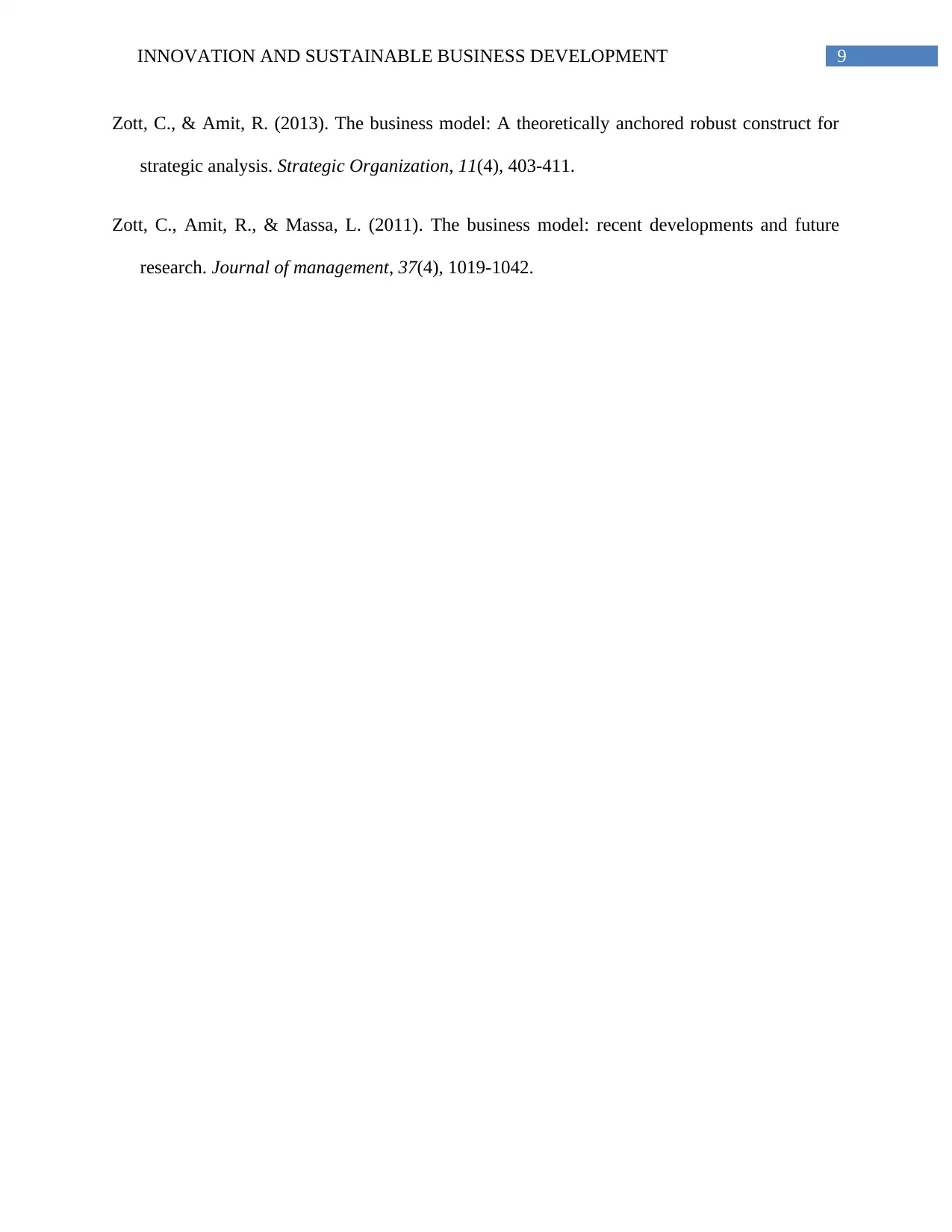
9INNOVATION AND SUSTAINABLE BUSINESS DEVELOPMENT
Zott, C., & Amit, R. (2013). The business model: A theoretically anchored robust construct for
strategic analysis. Strategic Organization, 11(4), 403-411.
Zott, C., Amit, R., & Massa, L. (2011). The business model: recent developments and future
research. Journal of management, 37(4), 1019-1042.
Zott, C., & Amit, R. (2013). The business model: A theoretically anchored robust construct for
strategic analysis. Strategic Organization, 11(4), 403-411.
Zott, C., Amit, R., & Massa, L. (2011). The business model: recent developments and future
research. Journal of management, 37(4), 1019-1042.
1 out of 10
Related Documents
Your All-in-One AI-Powered Toolkit for Academic Success.
+13062052269
info@desklib.com
Available 24*7 on WhatsApp / Email
![[object Object]](/_next/static/media/star-bottom.7253800d.svg)
Unlock your academic potential
Copyright © 2020–2025 A2Z Services. All Rights Reserved. Developed and managed by ZUCOL.





